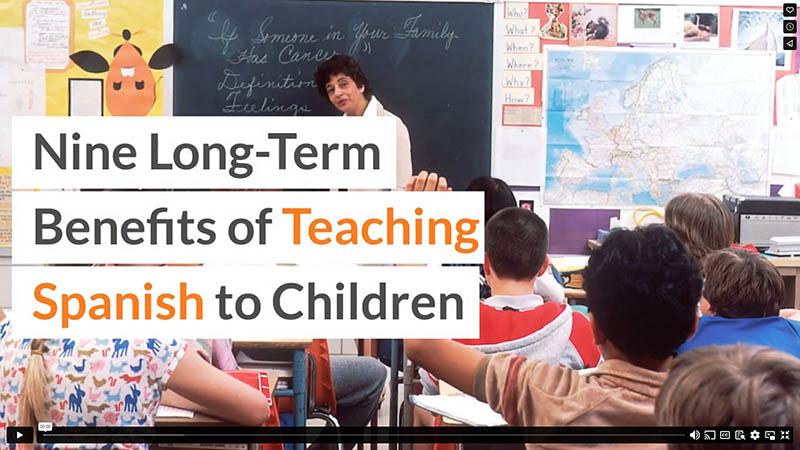Perhaps you’ve marveled at your child’s ability to quickly memorize a poem for school, pick up a new skill, or spout a plethora of obscure facts about their favorite movie. You may have even found yourself thinking, “I could never do that!”.
It’s true, children are at an advantage when it comes to learning. A recent study in Current Biology found that, due to concentrated amounts of a brain messenger known as GABA, “children’s brains respond to training in a way that allows them to more quickly and efficiently stabilize new learning” (Cell Press).
Here at The Academy of Scholars, our teachers have found that one way to take advantage of this reality is to promote bilingualism in children. And, because it is the second most-used language in the world, Spanish has become a popular choice. The benefits of learning Spanish as a second language during formative years are many, and you can be sure that such learning will give your child an advantage in their education and beyond.
Teaching Spanish to Children…
Develops early language skills.
Children learn new words rapidly, often by simply hearing them in context and trying them out for themselves. They are wired to soak up language like a sponge to communicate with those around them. Studies have shown that younger children display a stronger ability to pronounce unfamiliar words and sounds and pick up on grammar rules. Teaching Spanish is a great way to hone these skills and expand their language repertoire.
Gives a better understanding of the English language.
When children learn English as a first language, it typically happens through everyday communication and listening to those around them. For this reason, many of the technicalities and the why behind the language’s makeup are skipped over. Learning Spanish in the classroom, along with the rules of Spanish grammar, allows children to look at the building blocks of spoken and written language, even their own.
Provides an academic advantage.
Studies have shown that learning a second language improves problem-solving, memory, multitasking, and critical thinking skills. It has also shown higher academic achievement and is often connected with delayed cognitive decline later in life.
Broadens a child’s relationships and interactions.
Spanish is the official language in 20 countries but can be found in many other countries. It is spoken by nearly 560 million people worldwide and by 13% of the United States population, though experts expect that number to grow to 30% by 2050.
These numbers make Spanish an increasingly valuable language, allowing children to better understand, communicate, and build relationships with their Spanish-speaking peers. It will also be useful should they ever travel to a Spanish-speaking country. Additionally, using someone’s native language shows consideration, respect, and a desire to connect.
Increases future chances of securing employment.
The demand for bilingual adults in the workplace is rapidly increasing, and this trend isn’t likely to change course. Nine of 10 employers hire bilingual employees, with Spanish being the most desired second language. Tech skills won’t be the only requirement when your children enter the workplace, so give them an advantage by encouraging fluency in Spanish.
Makes it easier to learn other Latin-based languages.
Spanish is a Latin-based language and therefore shares many rules and similarities with other languages such as French, Italian, Romanian, and Portuguese. By using Spanish as a foundation, children can pick up additional languages much more easily. Similarities will also help with understanding other languages when traveling, opening the door to many travel opportunities.
Increases a child’s cultural awareness and appreciation.
Kids will love immersing themselves in Spanish culture as they develop a deeper understanding of the language and those who speak it. Parents can cultivate their child’s appreciation by introducing them to unique foods, holidays, and traditions from various Spanish-speaking countries. Take it further by planning a family vacation to one of these locations, and let your child be the translator!
Is practical due to the abundance of learning material available.
Because it is the most learned second language, the learning resources for Spanish are vast and diverse. From flashcards to online interactive videos, you’ll find a jackpot of tools that can be used to encourage your child’s learning and to make it fun!
Teaches better communication skills.
Finally, students who learn Spanish as a second language have shown higher scores in reading, writing, grammar, and even speaking and listening. Learning Spanish helps a child become a better communicator, one of the most important skills a child (and adult) can possess.
The benefits of learning Spanish early in a child’s education are vast and valuable to many parts of their life and future. This is why more parents are giving their children the gift of learning Spanish. One of the best ways you can help your child become fluent at an early age is by enrolling them in a public or private school here in Atlanta that teaches Spanish. Doing so will give your child the boost they need for a better education and a brighter future.
Infographic
Teaching Spanish to children enhances language skills and deepens cultural understanding. Fluent speakers benefit from improved problem-solving, memory, and critical thinking, boosting academic success and job prospects. Early fluency opens global opportunities, fostering an appreciation for diverse cultures. Abundant practical tools make Spanish education enjoyable, prompting parents to enroll children for brighter futures.
Video


